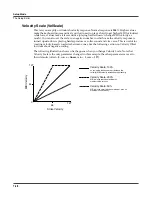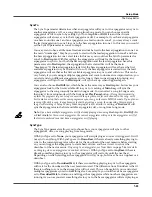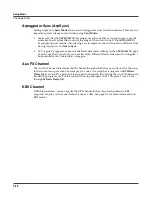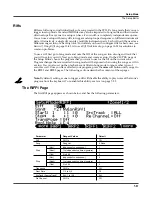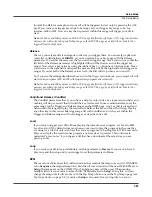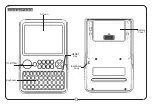
7-40
Setup Mode
The Setup Editor
Shift Amount
You can tell the Arpeggiator to transpose all of the currently latched notes each time it plays
through them. Shift determines how much transposition will occur for each cycle of notes. For
example, if you have latched C4 and F4, and you assign a Note Shift of 2, the Arpeggiator will
play C4, F4, D4, G4, E4, A4, and so on until it reaches the Limit value. The Shift values can range
from
-88
to
88
, with
0
(the default) being no transposition.
Shift Limit
Limit determines how far up or down the Arpeggiator shifts from the original note. The
minimum value is
0
, and the maximum is
60
. When the Arpeggiator reaches the limit, the
Arpeggiator responds according to the setting for the Limit Option parameter.
Limit Option
This parameter determines what the Arpeggiator does when it has shifted the currently latched
notes up (or down) to the shift limit.
Stop
causes the Arpeggiator to stop when it reaches the
shift limit.
Reset
causes the Arpeggiator to return to its original pitch and repeat the latched
cycle of notes, transposing each cycle according to the settings for Note Shift and Shift Limit. If
the limit allows the notes to go out of MIDI range (for example, if you set Shift to
12
, set the limit
to
60
, and play C6), then those “ghost” notes don’t sound, but they take up rhythmic space: the
Arpeggiator waits for the cycle to play itself out before starting over.
Unipolar
means that after playing up to the shift limit, the Arpeggiator begins shifting notes in
the opposite direction, until it reaches the original pitch, where it reverses again. To determine
the next note when it reaches the shift limit, the Arpeggiator calculates the interval between the
shift limit and what the next note would be if the shift limit weren’t there. It then plays the note
that is the calculated interval lower than the last note before the shift limit. The same thing
happens in reverse when the arpeggiated notes get back down to the original pitch. The
following table makes this easier to visualize by showing the result of arpeggiating one note
(C4) in Unipolar mode, with Note Shift set to
3 ST
and various values for Shift Limit.
Shift Limit
Resulting Arpeggiation (When LimitOption is Unipolar)
Comment
Up
Down
Up
6 ST (F#4)
C4, D
#
4, F
#
4,
D
#
4, C4
D#4, …
Same notes play in both directions
when Shift Limit is a multiple of
Note Shift
7 ST (G4)
C4, D
#
4, F
#
4,
E4, C
#
4,
D
#
4, …
Last upward note before shift limit is
F#4, next upward note would be
A4, which is 2 ST from shift limit
(G4); therefore first downward note
is E4 (2 ST below last upward note)
8 ST (G
#
4)
C4, D
#
4, F
#
4,
F4, D4,
D
#
4, …
A4 is 1 ST from shift limit, therefore
first downward note is F4 (1 ST
lower than last upward note)
9 ST (A4)
C4, D
#
4, F
#
4, A4
F
#
4, D
#
4, C4,
D#4, …
All symmetrical again; now A4 is
within shift limit
10 ST (A#4)
C4, D
#
4, F
#
4, A4,
G4, E4, C
#
4,
D
#
4, …
Next upward note would be C5,
which is 2 ST from shift limit
11 ST (B4)
C4, D
#
4, F
#
4, A4,
G
#
4, F4, D4,
D
#
4, …
C5 is 1 ST from shift limit
12 ST (C5)
C4, D
#
4, F
#
4, A4, C5,
A4, F
#
4, D
#
4, C4,
D#4, …
Symmetrical again, including C5
Summary of Contents for PC3LE6
Page 10: ...vi...
Page 24: ...2 10 Startup Software Upgrades...
Page 38: ...3 14 User Interface Basics Quick Song Recording and Playback...
Page 42: ...4 4 The Operating Modes Using the Modes...
Page 64: ...6 16 Program Mode The Program Editor...
Page 134: ...7 70 Setup Mode The Control Setup...
Page 138: ...8 4 Quick Access Mode The QA Editor...
Page 194: ...10 34 Song Mode and the Song Editor Song Editor The EVENT Page...



